Office Room Interior Design: Creating Inspiring Workspaces
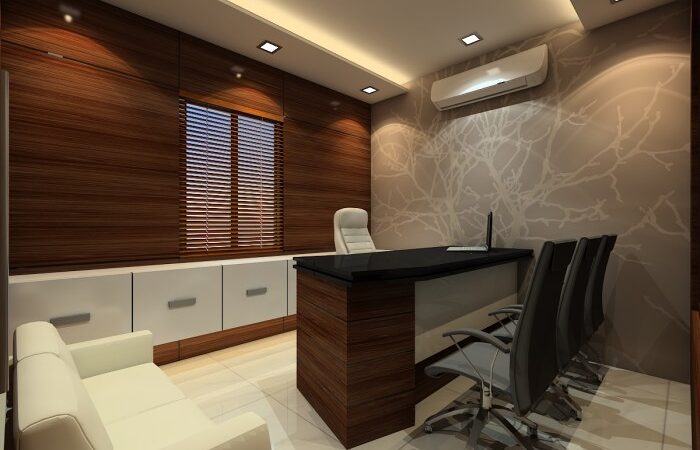
Office room interior design is more than just aesthetics; it’s about crafting an environment that fosters productivity, creativity, and well-being. A well-designed office space can significantly impact employee morale, collaboration, and overall performance. From the layout and furniture to the color scheme and lighting, every element plays a role in shaping the atmosphere and functionality of the workspace.
This guide explores the key considerations for designing an office room that meets the needs of its occupants and promotes a positive work environment. We’ll delve into functional aspects like workflow optimization and technology integration, explore aesthetic elements that create a visually appealing space, and discuss strategies for promoting a productive and inspiring atmosphere.
We’ll also touch on sustainability and budget-friendly design solutions.
Understanding the Office Space

Before embarking on the design process, it is crucial to understand the specific needs and requirements of the office space. This includes analyzing the purpose of the office, identifying the target audience, understanding the desired work environment and culture, and recognizing the impact of natural light and ventilation on the space.
Purpose of the Office Room
The purpose of the office room dictates its design. For example, a creative agency might require an open, collaborative space with a focus on visual elements. In contrast, a law firm might need a more formal and private setting.
Target Audience
The target audience for the office space plays a vital role in determining the design. For example, a startup company might want a modern, dynamic space to attract young, tech-savvy talent. In contrast, a traditional company might prefer a more classic and sophisticated setting.
Desired Work Environment and Culture
The desired work environment and culture directly influence the design choices. A company that values collaboration might choose an open floor plan with shared workspaces. In contrast, a company that emphasizes individual focus might prefer private offices with dedicated work areas.
Impact of Natural Light and Ventilation
Natural light and ventilation significantly impact the well-being and productivity of employees. Adequate natural light can improve mood, focus, and overall health. Good ventilation ensures a fresh and comfortable work environment.
Functional Considerations
Creating a functional office space involves considering the practical aspects of how the space will be used. This includes optimizing workflow, facilitating collaboration, and ensuring the space is equipped with the necessary technology. A well-designed office space should also prioritize the well-being of its occupants through ergonomic solutions.
Designing a Layout for Optimized Workflow and Collaboration
The layout of an office space plays a crucial role in how efficiently people work and interact. A well-planned layout can foster collaboration, streamline workflows, and create a more productive environment.
- Open Plan Layout:This layout is characterized by open spaces with minimal partitions, promoting communication and interaction. It is often used in companies that emphasize collaboration and transparency.
- Cellular Layout:This layout features individual offices or workstations, providing privacy and quiet for focused work.It is suitable for tasks requiring concentration and confidentiality.
- Hybrid Layout:This layout combines elements of open and cellular layouts, offering a balance between collaboration and individual work. It can include shared work areas, meeting rooms, and private offices.
Planning Furniture Arrangement
Choosing and arranging furniture is essential for creating a functional and comfortable office space. This includes selecting the right desks, chairs, and storage solutions.
- Desks:Desks should be spacious enough for comfortable work, with adequate space for a computer, documents, and personal items. Consider adjustable height desks to promote ergonomic posture.
- Chairs:Ergonomic chairs with adjustable features, such as lumbar support and armrests, are crucial for comfort and preventing injuries.
- Storage:Sufficient storage is necessary to keep the workspace organized. This can include filing cabinets, shelves, and drawers. Consider using vertical storage solutions to maximize space.
Incorporating Technology into the Office Space
Technology plays a significant role in today’s workplaces. Integrating technology into the office space is essential for productivity and communication.
- High-Speed Internet:Reliable and fast internet access is crucial for efficient communication, data sharing, and online collaboration.
- Video Conferencing:Equip meeting rooms with high-quality video conferencing systems for effective virtual meetings and collaborations.
- Wireless Connectivity:Provide wireless internet access throughout the office to enable mobile working and device connectivity.
- Smart Technology:Consider incorporating smart devices like voice assistants, smart lighting, and automated temperature controls for increased efficiency and convenience.
Ergonomic Solutions for Office Furniture
Ergonomics focuses on designing workspaces and furniture to promote comfort, reduce strain, and prevent injuries. Investing in ergonomic furniture can improve employee well-being and productivity.
- Adjustable Height Desks:Allow employees to switch between sitting and standing positions throughout the day, promoting better posture and blood circulation.
- Ergonomic Chairs:Features such as adjustable lumbar support, armrests, and seat height allow for customized comfort and proper posture.
- Keyboard Trays:Reduce strain on wrists and forearms by positioning the keyboard at an optimal height.
- Footrests:Support proper leg positioning and reduce pressure on the lower back.
Aesthetic Design Elements
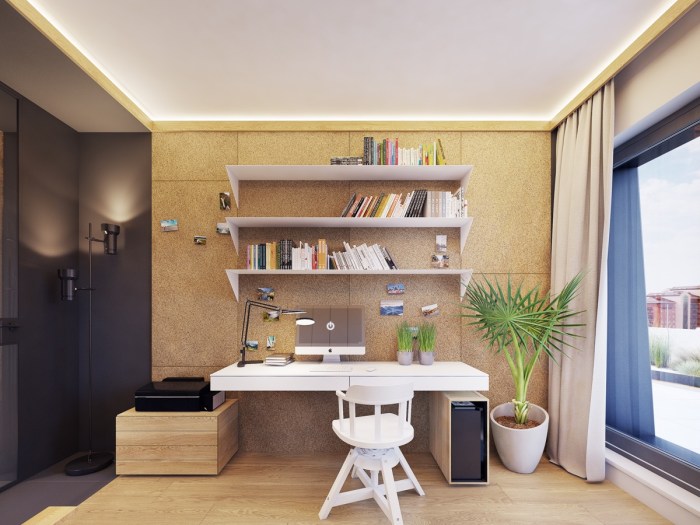
Aesthetic design elements play a crucial role in creating a functional and inspiring office space. By carefully considering the visual appeal of the office, you can foster a positive and productive work environment.
Color Psychology in Office Design
The use of color in office design can significantly impact the mood, productivity, and overall atmosphere of the workspace. Color psychology explores the psychological effects of different colors on human behavior and emotions.
- Blueis often associated with calmness, focus, and productivity, making it a popular choice for office spaces. It can promote a sense of tranquility and encourage concentration.
- Greenis linked to nature, growth, and renewal. It can create a sense of peace and reduce stress, making it ideal for areas where employees need to relax or take a break.
- Yellowis associated with energy, optimism, and creativity. It can stimulate mental activity and encourage innovation, making it suitable for brainstorming areas or meeting rooms.
- Redis known for its stimulating and energizing qualities. However, excessive red can be overwhelming, so it’s best used sparingly as an accent color.
- Orangeis a vibrant and warm color that can boost energy levels and creativity. It’s often used in collaborative spaces to promote teamwork and communication.
Incorporating Natural Elements
Bringing elements of nature into the office can significantly enhance the well-being and productivity of employees. Natural elements create a sense of connection to the outdoors, reducing stress and improving focus.
- Plants: Plants not only add visual appeal but also improve air quality, reduce noise levels, and create a more relaxing atmosphere. Studies have shown that having plants in the office can increase productivity and creativity.
- Wood Accents: Wood is a natural material that brings warmth, texture, and a sense of grounding to an office space. Wood accents can be incorporated through furniture, flooring, wall panels, or decorative elements.
- Natural Light: Maximize natural light by using large windows and skylights. Natural light has been proven to improve mood, reduce fatigue, and increase productivity.
Impact of Lighting on Atmosphere
Lighting plays a crucial role in setting the overall atmosphere of an office. The type and intensity of lighting can significantly impact mood, productivity, and employee well-being.
- Natural Light: As mentioned previously, maximizing natural light is essential for a healthy and productive workspace. However, it’s important to consider glare and ensure that employees have adequate shade options.
- Artificial Light: When using artificial light, consider the color temperature. Cool white light (around 4000K) is ideal for task-oriented workspaces, while warmer white light (around 2700K) is better suited for relaxation areas or break rooms.
- Layered Lighting: Creating a layered lighting system with a combination of ambient, task, and accent lighting can enhance the functionality and aesthetics of the space. Ambient lighting provides general illumination, task lighting focuses on specific work areas, and accent lighting highlights specific features or artwork.
Artwork and Decorative Elements
Artwork and decorative elements can add personality, inspire creativity, and enhance the overall aesthetic of an office space. When selecting artwork, consider the company culture, brand identity, and the overall design scheme of the office.
- Abstract Art: Abstract art can stimulate creativity and encourage contemplation, making it a good choice for brainstorming areas or meeting rooms.
- Nature Photography: Nature photography can bring a sense of tranquility and peace to the office, reducing stress and promoting relaxation.
- Inspirational Quotes: Displaying inspirational quotes or motivational artwork can boost employee morale and create a positive work environment.
- Sculptures: Sculptures can add a touch of elegance and sophistication to the office, creating a more refined and inspiring atmosphere.
Creating a Productive Environment: Office Room Interior Design
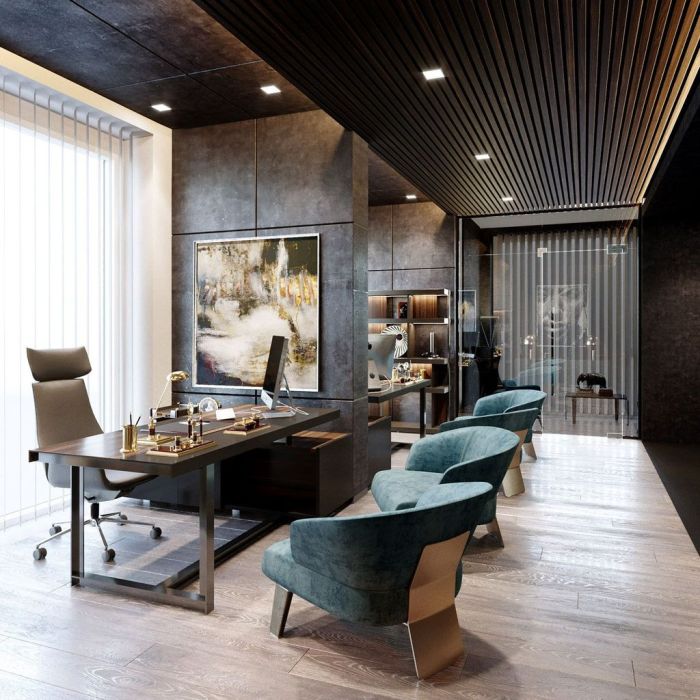
A well-designed office space goes beyond aesthetics; it plays a crucial role in fostering a productive and positive work environment. This section delves into strategies for creating a workspace that promotes focus, collaboration, and overall well-being.
Acoustics and Noise Control
Effective noise management is essential for maximizing productivity. Unwanted noise can disrupt concentration, lead to fatigue, and negatively impact communication. Implementing appropriate acoustic solutions can significantly improve the overall work experience.
- Sound-absorbing materials:Incorporating sound-absorbing materials like acoustic panels, carpets, and curtains can effectively reduce noise levels and create a quieter work environment. These materials absorb sound waves, preventing them from bouncing around and creating echoes.
- Strategic furniture placement:Arranging furniture in a way that minimizes noise transmission can also be beneficial. For instance, placing workstations away from high-traffic areas and using partitions or screens to create visual and acoustic separation can help reduce distractions.
- White noise generators:White noise generators can mask distracting background noise by emitting a consistent, calming sound. They can be particularly helpful in open-plan offices or areas with constant ambient noise.
Designated Areas for Different Activities, Office room interior design
Creating designated areas for specific activities, such as meetings, collaboration, and breaks, can enhance focus and productivity. This approach allows individuals to move between spaces tailored to their needs, fostering a more dynamic and efficient workflow.
- Meeting rooms:Dedicated meeting rooms provide a quiet and professional setting for team discussions, presentations, and brainstorming sessions. These spaces should be equipped with comfortable seating, appropriate technology, and ample whiteboards or projection screens.
- Collaboration areas:Collaborative areas, often designed with informal seating arrangements and writable surfaces, encourage spontaneous interactions and team projects. These spaces can be equipped with comfortable couches, bean bags, or standing desks, promoting a more relaxed and creative atmosphere.
- Break areas:Break areas offer a space for employees to relax, recharge, and socialize. They can be equipped with comfortable seating, coffee machines, microwaves, and refrigerators. A well-designed break area encourages a sense of community and provides a much-needed respite from the workday.
Privacy and Individual Workspaces
Providing employees with private and individual workspaces is essential for fostering concentration and focus. This can be achieved through various design strategies, ensuring everyone has a dedicated space to work without distractions.
- Private offices:Private offices offer a quiet and secluded space for individuals who require a high level of concentration or privacy. These offices can be designed with soundproof walls, comfortable desks, and storage solutions to ensure a productive and organized workspace.
- Enclosed workstations:Enclosed workstations, often featuring high partitions or dividers, offer a degree of privacy and noise reduction without completely isolating employees. They can be equipped with adjustable desks, comfortable chairs, and task lighting to create a comfortable and functional workspace.
- Flexible work arrangements:Implementing flexible work arrangements, such as remote work options or flexible hours, can also contribute to employee well-being and productivity. This allows individuals to work in environments that best suit their needs and preferences, promoting a healthy work-life balance.
Creating a Sense of Community and Team Spirit
A sense of community and team spirit is vital for fostering a positive and collaborative work environment. Design elements that promote interaction and social connection can contribute to a more engaged and motivated workforce.
- Open and inviting spaces:Creating open and inviting spaces, such as common areas, kitchens, or breakout zones, encourages social interaction and collaboration. These spaces should be designed with comfortable seating, natural light, and inviting décor to foster a sense of community and belonging.
- Team-building activities:Regular team-building activities can help strengthen relationships, improve communication, and foster a sense of camaraderie. These activities can range from informal social gatherings to structured team-building exercises designed to promote collaboration and problem-solving skills.
- Employee recognition programs:Recognizing and celebrating employee achievements can boost morale and create a positive work environment. This can be done through formal awards programs, informal recognition initiatives, or simply by expressing appreciation for a job well done.
Sustainability and Eco-Friendly Design
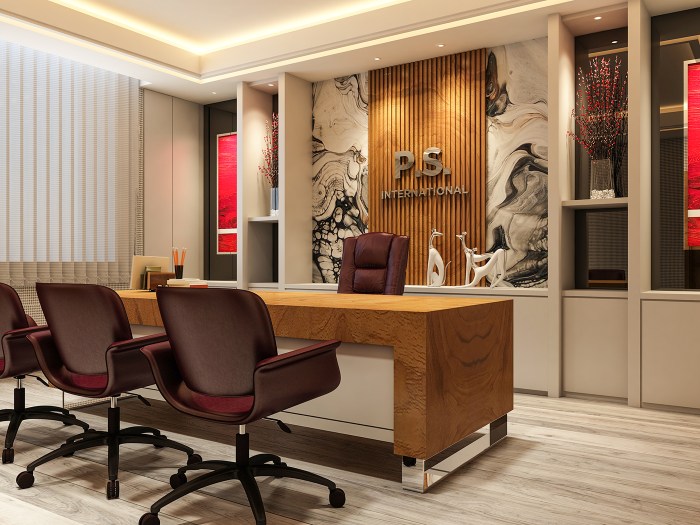
Sustainability is becoming increasingly important in all aspects of life, including office design. By incorporating eco-friendly practices, businesses can reduce their environmental impact, improve employee well-being, and create a more responsible and sustainable workplace.
Sustainable Materials
Sustainable materials are those that are sourced responsibly, have minimal environmental impact during production and use, and are durable and long-lasting. Using these materials in office design offers numerous benefits:
- Reduced environmental impact:Sustainable materials minimize the use of harmful chemicals and emissions, conserving resources and reducing pollution.
- Improved indoor air quality:Natural and low-VOC materials contribute to a healthier and more comfortable indoor environment for employees.
- Enhanced employee well-being:Biophilic design, which incorporates natural elements like wood and plants, promotes a sense of connection to nature and improves employee well-being.
- Cost savings:Sustainable materials often have a longer lifespan, reducing the need for frequent replacements and maintenance costs.
Energy-Efficient Lighting and Appliances
Energy-efficient lighting and appliances play a crucial role in reducing energy consumption and operating costs. Consider these options:
- LED lighting:LED lights are highly energy-efficient, lasting longer than traditional incandescent bulbs and emitting less heat.
- Smart lighting systems:These systems automatically adjust lighting levels based on occupancy and natural light, minimizing energy waste.
- Energy-efficient appliances:Choose appliances with high energy efficiency ratings, such as ENERGY STAR certified products, to minimize energy consumption.
Waste Management and Recycling
Implementing effective waste management and recycling programs is essential for reducing the office’s environmental footprint. Here are some key aspects:
- Waste reduction:Encourage employees to reduce waste by using reusable items, minimizing single-use plastics, and opting for digital communication whenever possible.
- Recycling:Provide clearly labeled recycling bins for different materials, such as paper, plastic, and glass, to ensure proper waste separation.
- Composting:Consider composting organic waste, such as food scraps and yard waste, to create nutrient-rich soil for landscaping or gardens.
Eco-Friendly Furniture and Decor Options
Choosing eco-friendly furniture and decor options can contribute to a sustainable office design. Here are some examples:
- Recycled or reclaimed materials:Look for furniture made from recycled materials, such as reclaimed wood or plastic, to reduce waste and promote sustainability.
- Sustainable wood:Opt for furniture made from sustainably harvested wood, certified by organizations like the Forest Stewardship Council (FSC).
- Locally sourced materials:Choosing furniture and decor made from locally sourced materials minimizes transportation costs and environmental impact.
- Biodegradable materials:Consider using biodegradable materials for office supplies and decor, such as bamboo or cornstarch-based products.
Budget Considerations
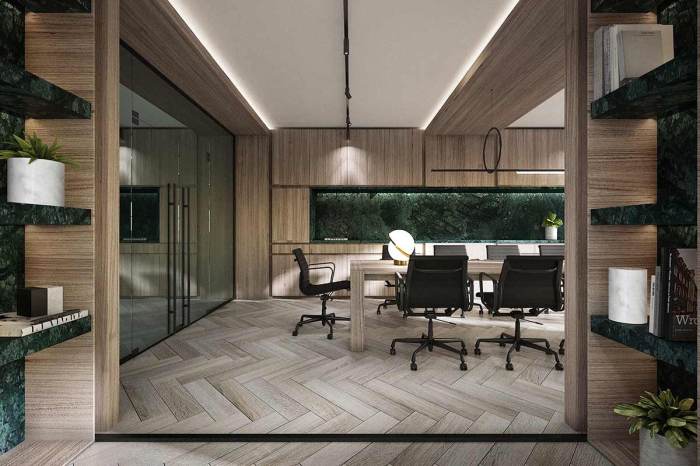
Designing an office room interior within a specific budget requires careful planning and strategic decision-making. It’s about striking a balance between aesthetics, functionality, and affordability. This section explores ways to create a stylish and functional office space without breaking the bank.
Cost-Effective Furniture and Decor Options
Finding affordable yet stylish furniture and decor is essential for budget-conscious office design. Consider these options:
- Secondhand Furniture:Explore thrift stores, antique shops, or online marketplaces for pre-owned furniture. You can often find high-quality pieces at a fraction of the cost of new ones. For instance, a vintage desk with character could be a statement piece in your office, adding a unique touch without breaking the bank.
- Modular Furniture:Modular furniture systems offer flexibility and affordability. You can purchase individual components and customize your office layout to fit your needs and budget. Many manufacturers offer a range of styles and finishes, allowing you to create a cohesive look without spending a fortune.
- DIY Decor:Get creative and personalize your office with DIY decor projects. Repurpose old items, create artwork from found objects, or paint your own accent wall. This can add a personal touch and save you money compared to buying expensive artwork or decorative pieces.
- Affordable Lighting:Lighting plays a crucial role in office design. You can find stylish and functional lighting options without breaking the bank. Consider using a combination of natural light and artificial light sources, such as LED bulbs, which are energy-efficient and long-lasting.
Trade-Offs Between Affordability and Aesthetics
Balancing affordability and aesthetics is a common challenge in office design. There are several ways to approach this:
- Prioritize Functionality:If your budget is tight, prioritize functionality over aesthetics. Choose durable and practical furniture that will last. You can always add decorative elements later on as your budget allows.
- Focus on Key Pieces:Invest in a few key pieces that will make a statement, such as a unique desk or a comfortable chair. You can then complement these pieces with more affordable accessories and decor.
- Use Color and Texture:Color and texture can add visual interest and personality to an office without breaking the bank. Consider using a bold accent wall, adding patterned rugs, or incorporating textured throw pillows. These simple touches can transform the look of your office without requiring expensive furniture upgrades.
Maximizing the Use of Existing Furniture and Resources
Don’t underestimate the value of your existing furniture and resources. Here are some ways to maximize their use:
- Repurpose Furniture:An old dresser can be transformed into a filing cabinet or a desk with a few simple modifications. Consider repainting or refinishing existing furniture to give it a new look.
- Multifunctional Furniture:Choose furniture that serves multiple purposes. A sofa bed can be a comfortable seating area and a guest bed. A storage ottoman can provide seating and storage space.
- Creative Storage Solutions:Utilize existing storage space efficiently. Consider installing shelves, using baskets for organization, or repurposing old boxes as storage containers.
Closure
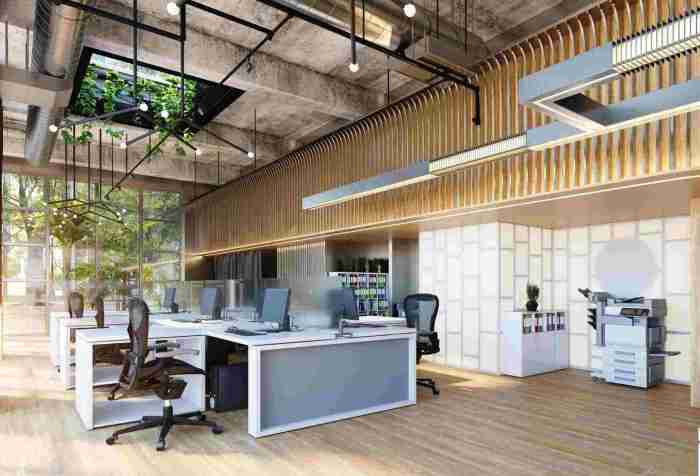
By thoughtfully addressing the various aspects of office room interior design, you can create a workspace that is not only functional but also visually appealing, comfortable, and conducive to productivity. Whether you’re designing a home office or a corporate headquarters, the principles Artikeld in this guide can help you create an environment that inspires and motivates your team.
Comments are closed.